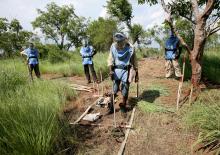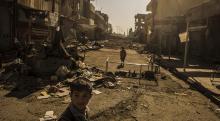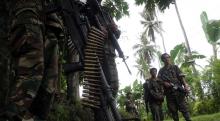Basic international humanitarian law (IHL) rules applicable to this situation:
The use of means and methods of warfare which cause superfluous injury or unnecessary suffering is prohibited.
When landmines are used, particular care must be taken to minimize their indiscriminate effects.
A party to the conflict using landmines must record their placement, as far as possible.
At the end of active hostilities, a party to the conflict which has used landmines must remove or otherwise render them harmless to civilians, or facilitate their removal.
The case in brief
Five decades of armed conflict between the Colombian government and the Revolutionary Armed Forces of Colombia – People’s Army (FARC-EP), a non-state armed group, left parts of Colombia littered with landmines. The mines caused large-scale death, injury and displacement and, in some areas, hindered access to schools and health services.
The parties began peace negotiations in 2012, reaching a final agreement in November 2016. Between May 2015 and November 2016, in support of the peace process, the parties worked jointly to demine two communities. In a coordinated effort supported by international actors, FARC-EP members located the mines while the Colombian government cleared them. Besides restoring safety to these historically isolated communities, the project strengthened their relations with government, bringing improvements to local infrastructure and socio-economic benefits.
IHL compliance highlights
- In March 2015, as a confidence-building step in the peace process, the Colombian government and the FARC-EP agreed to work together on mine action.
- Having agreed to trial the project in the heavily mined communities of El Orejón and Santa Helena, FARC-EP members, public officials and Colombian military personnel worked alongside each other to coordinate activities on the ground. Joint teams surveyed affected areas in cooperation with local authorities and Norwegian People’s Aid. Former FARC-EP soldiers used their knowledge of where the mines had been laid, while the government provided technical expertise and equipment to clear them.
- To prevent mine-related accidents, the teams raised public awareness of mine risks and marked out dangerous areas for future clearance. Mechanisms were established to monitor progress and keep the communities informed, thereby building their trust.
- In total, the teams cleared some 40,000 sq m of land and destroyed 67 landmines, making the communities safe again.
Case prepared by Emma Persson, James Patrick Sexton, and Shaya Javadinia, LL.M. students at Leiden University, under the supervision of Professor Robert Heinsch, as well as Alla Ershova (Senior Researcher) and Ashley Peltier (Researcher) Kalshoven-Gieskes Forum, Leiden University.
A. COLOMBIA AND FARC AGREE TO DEMINE RURAL AREAS
[Source: International Crisis Group, ‘Demining the Path to Peace in Colombia,’ 10 March 2015, available at https://www.crisisgroup.org/latin-america-caribbean/andes/colombia/demining-path-peace-colombia, accessed on 31 January 2021]
On 7 March, negotiators for the Colombian government and the Revolutionary Armed Forces of Colombia (FARC) announced they would embark on a joint demining effort. After two and a half years of negotiations in the Cuban capital of Havana, and outline agreements on three agenda points, this is the first accord that will have a direct impact on the ground, delivering long overdue humanitarian relief and bringing Colombia a big step closer to ending five decades of bloodshed.
Colombia is one of the most landmine-contaminated countries in the world. Since guerrillas began systematically using them in the early 1990s, the devices have killed or injured over 11,000 persons, mostly members of the security forces. Landmines are now a threat in about 700 of Colombia’s 1,100-odd municipalities, and have contributed to displacing over six million Colombians. In the most dangerous regions, such as the southern Lower Putumayo region, landmine contamination blocks communities’ access to schools, health services and local markets.
According to a joint statement, the government and FARC will first select a number of pilot zones with the highest level of threat for anti-personnel mines, improvised explosive devices (IEDs), unexploded ordnance (UXO) or explosive remnants of war (ERW). Norwegian People’s Aid, a humanitarian non-governmental organisation (NGO), will then survey where most of the explosive devices are. This is a particular challenge in Colombia, where mines are often widely dispersed, not laid out in regular patterns. Reliable maps are also often absent. Following mine clearance, safe territories will be handed over to communities and local authorities.
[...]
B. THE JOINT DEMINING PROJECT
[Source: European Commission, European Instrument contributing to Stability and Peace (IcSP) and Peace Direct, ‘Making Colombia Safe Again: Demining Mountain Communities’, March 2017, available at https://fpi.ec.europa.eu/system/files/2018-09/colombia-showcase-final_0_0.pdf, accessed on 20 May 2022]
[...]
Locals in the lead
The project took place in two remote villages directly affected by the war: El Orejón, in the Antioquia region, and Santa Helena, in the Meta region. The communities are in some of the most heavily mined areas of the country, and have seen many people killed or injured by antipersonnel mines and other unexploded ordnance.
The work began with joint analysis of the situation on the ground. The communities in El Orejón and Santa Helena helped carry out studies to determine the location of landmines. This allowed the project team to establish links to local authorities, building political trust for the work.
Government officials, Colombian soldiers and FARC members then worked together to identify and remove them. This joint effort was crucial. The combination of former FARC soldiers, with their knowledge of where mines had been planted, with the technical expertise of the government, was indispensable. As well as physically removing mines, the project ran educational programmes to prevent accidents, and marked out other dangerous areas for future projects. The project ran community dialogue and verification mechanisms to monitor the work.
Safer communities
The physical objective was to restore a safe environment for locals, and this was a full success. El Orejón, with 80 inhabitants in 25 families, was considered to be an area highly contaminated with anti-personnel mines and unexploded ordnance. During the implementation of the pilot 11 dangerous areas were identified.
During the first phase in 2015, four areas were surveyed by the Non-Technical survey teams, covering 13,007m². 14,713m² of land were cleared and 33 landmines were found and destroyed. An area of around 42,000m² was also marked. This area was considered a Suspected Hazardous Area (SHA), because of information provided by locals of constant FARC activities in the area, without factual evidence of any explosive items. During Phase Two, in 2016, six areas totalling 4022m² were identified and 5136m² cleared. 14 landmines were found and destroyed.
In Santa Helena, a village of 100 people, seven areas were identified as SHAs. During Technical Survey activities, operations for one area were cancelled because of a lack of evidence of contamination. Two areas were marked - considered as SHAs - and four areas totalling 20,874m² were cleared. 20 landmines were found and destroyed.
In total, 67 landmines across the pilot projects were destroyed.
[...]
The project also provided new skills to the community, and improved its relationship with government institutions. These have now begun to provide socio-economic, health, education, victim and infrastructure assistance to what had been historically isolated areas.
A key local leader in El Orejón is Eugenia Holguín. She is the president of the local community association, and says that the project has created a big impact. “It changed El Orejón. We were able to have a proper school. The old one was abandoned and people were scared. Now we have a new school, and a new community house as well.”
[...]
C. THE PATH TO LONG-TERM PEACE
[Source: European Commission, European Instrument contributing to Stability and Peace (IcSP) and Peace Direct, ‘Making Colombia Safe Again: Demining Mountain Communities’, March 2017, available at https://fpi.ec.europa.eu/system/files/2018-09/colombia-showcase-final_0_0.pdf, accessed on 20 May 2022]
[...]
[The project] managed to establish an effective commitment from local FARC representatives and the government to work together. This will be vital if the peace deal is to be a success. And action followed words: on the ground, quarters were established to coordinate the implementation of the project. Members of FARC, public officials and soldiers lived and worked together.
[...]
All the staff wore the same uniforms, and relations with FARC were good. As members of the technical team said: “We celebrated birthdays and special dates together. When we were sick, we [looked after each other] together.”
“We even had a football team. We were no more FARC delegates or government delegates, we were together, and this was strongly reflected in Cuba at political level.”
[...]
The project was effectively an entry point for the Colombian state to reach communities who had considered themselves abandoned. And after the experience of the demining work, other government departments began making proposals for health care, education and infrastructure projects.
The work was also a technical success. It helped establish new standards in Colombia, including the use of mechanical demining, the development of environmental rules, and procedures for medical evacuations. Project director Sergio Bueno says the results are clear.
“The pilot projects in El Orejón and Santa Helena have shown that demining is one of the most effective instruments of peacebuilding. It helped not just in the specialist demining operation, but also to strengthen social cohesion.”
Demining in Colombia shows that communities can overcome the legacy of terrible and divisive conflict. The hope now must be that others can follow this powerful example.
[...]
[Source: La Patria, ‘En el Orejón viven libres de minas antipersonal’, 22 December 2016, available at https://www.lapatria.com/nacional/en-el-orejon-viven-libres-de-minas-antipersonal-337685, accessed on 31 January 2021]
[...]
"Hoy poder entregar unos polígonos descontaminados nos llena de alegría y da un mensaje al país de que la paz en los territorios en las comunidades, en las regiones, va tomando fuerza. (...) Y Orejón fue como la metáfora de la esperanza en el proceso de paz", dijo alias Pastor Alape, plenipotenciario de las Farc.[1]
[...]
Discussion
I. Classification of the Situation and Applicable Law
- How would you classify the situation at the time between the FARC-EP and Colombia? Does the fact that the FARC-EP [ALV1] was a non-State actor affect this classification? (GC I-IV, Art. 2, Art. 3; P I, Art. 1; P II, Art.1)
- What IHL rules regulate the obligations regarding landmines? Were these rules different for Colombia and FARC-EP? (CCW, Art. 1; CCW Amended Protocol II, Art. 1; Ottawa Convention, Art. 1, Art. 5; CIHL, Rule 70, Rule 81, Rule 82, Rule 83)
II. Demining Action
- Did Colombia have a duty to remove the landmines in Santa Helena and El Orejón? Does it matter when the mines were planted, or who planted them? (Ottawa Convention, Art. 5; CCW Amended Protocol II, Art. 3, Art. 10; CIHL, Rule 83)
- Did the FARC-EP have a duty to remove landmines? Were there fewer obligations for the FARC-EP than for Colombia? If so, how do these obligations differ? (CIHL, Rule 83; CCW Amended Protocol II, Art. 1Art. 3(2), Art. 10)
- While the original CCW Protocol II does not apply to non-State actors such as the FARC-EP, the Amended Protocol II does. Why has IHL increasingly developed to include non-State actors? (CCW Protocol II, Art. 1; CCW Amended Protocol II, Art. 1)
- Article 10(4) of the CCW Amended Protocol II requires that parties to a conflict “endeavour to reach agreement” between themselves and with the international community to assist in demining programmes. Do you think that the parties have done so in the present case? Why does this Protocol explicitly encourage the international community’s assistance? (CCW Amended Protocol II, Art. 10)
III. Elements Contributing to Respect for IHL
- (Document C) In your view, why was the issue of demining chosen by the FARC-EP and Colombia as a way to begin the peace process? What is it about demining that speaks to cooperation? Is cooperation on demining an effective way of building trust between parties?
- (Documents B and C) In your opinion, what incentives do non-State actors have to engage in mine clearance? Do you think one of FARC-EP's motivations to assist in the mine clearance operation was to help reintegrate its members into society?
- (Document A and B) In what ways may the demining project positively have impacted the communities’ access to basic needs such as health and education? In your view, did the demining efforts improve the public’s perception of the Colombian Government and the FARC-EP?
- (Document A and B) Are there benefits to having neutral international actors such as the IcSP and Norwegian People's Aid work with parties on demining projects? Do you think international funding and technical support played a critical role in the mine-clearance operations?
[1] Translation by the KGF researchers: “Today being able to deliver some decontaminated units of land fills us with joy and gives a message to the country that peace in the territories, in the communities, in the regions, is gaining strength [...] And Orejón was like the metaphor of hope in the peace process”, said alias Pastor Alape, plenipotentiary of FARC.






